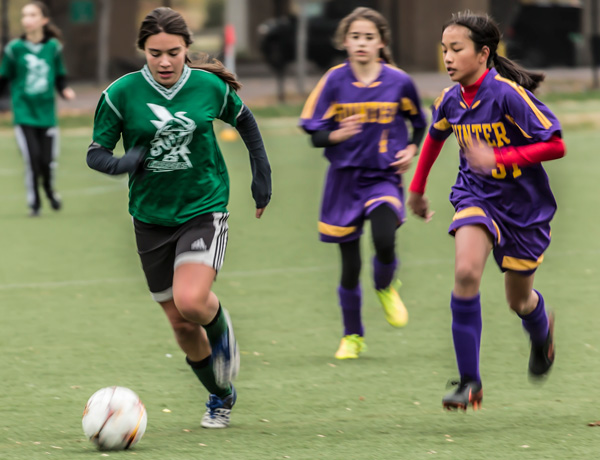
Manhattan Youth, which runs middle school sports programs Downtown, has high participation among girls, but high schools have had more trouble achieving equity.
BY ZACH WILLIAMS | Gender equity remains a concern in public high school sports, but the Downtown community is finding its own ways of evening the playing field while the city catches up.
An influx of new city funding has led to a dramatic expansion of sports offerings at the middle school and elementary levels. But it was in January that the city Department of Education reached an accord with the federal government which mandates that the city improve athletic opportunities for girls in local prep sports just as one local Downtown school was gathering the resources to fund a team on their own initiative.
The D.O.E. denied in a Jan. 22 agreement with the federal Department of Education that it violated Title IX, part of a 1972 law mandating equal emphasis on girls’ and boys’ sports by school districts which receive federal funding.
Nonetheless, the city opted to come to terms with federal officials in order to resolve a complaint made in 2010 by the National Women’s Law Center about city schools.
“It is long past time for schools to give girls what they need, deserve and are entitled to under the law,” Marcia D. Greenberger, co-president of the center, said in a statement.
The timing of the agreement coincided with the recently successful effort to add a varsity softball program at Millennium High School in the Financial District, but the balance came at a cost to the girls’ families — they had to raise the money themselves. Thus far, donors have contributed more than $16,000 for the team.
Students, parents and staff there relied upon an online funding effort to help secure funding for the upcoming team.
Female athletes now exceed their male counterparts at the school 109 to 101, athletic director Brian Friedman said in a March 23 email. Twelve varsity sports teams are evenly split between boys and girls, he added.
But the fundraising effort sent the wrong message, according to Community Board 1 member Paul Hovitz, co-chairperson of the Youth and Education Committee. Girls should not have to rely upon such extraordinary measures, he said in a telephone interview.
“It is unfair that the girls team is not funded like the boys team. There should be equity there,” he said.
The process through which new sports are added to city high schools will change per the Jan. 22 agreement.
Principals right now have to request new sports teams but soon coaches, parents and students will be able to directly apply to D.O.E. Records will be stored and the department will conduct assessments of unfulfilled athletic interests of female students at city high schools, according to the agreement. Athletic Directors will also receive training in Title IX.
City education officials did not answer questions about the Title IX agreement with the feds.
The city did claim compliance with Title IX by arguing that the department demonstrated a history of responsiveness to the interests and abilities of female students, but the federal government did not concur.
From school years 2002-03 to 2009-10, 353 girls’ teams were added but 309 were eliminated within the same time period, according to the federal investigation. Meanwhile, 478 boys’ teams were added while 340 teams were eliminated leading to a net increase of 138 boys’ teams but only 44 girls’ teams. Overall, 2,425 more participation opportunities were added for boys than girls.
D.O.E. budgeted an additional $1 million for the next four fiscal years to add a total of 96 new girls teams by 2019, according to the department statement. But elsewhere the city has made a bigger commitment to youth sports and programs for younger students.
“It’s not an equality issue. It’s a money issue.” John De Matteo — athletic director at P.S. 126 and commissioner of the Middle School Athletic League — said of lingering inequity between athletic opportunities for girls and boys.
He has been able to provide gender balance, but he said it’s more difficult to accomplish that at the high school level.
There are differences in the level of resources necessary to start a new team at the high school versus middle school and elementary schools, he added. Prep sports tend to practice every day, spurring competition for playing space. Younger athletes hone their skills fewer times a week, allowing for multiple teams for the same sport, he added.
This sharing of resources also extends to coaching staff, said De Matteo who currently oversees nine different teams.
“I could never do that at the high school level,” he said in a telephone interview.
An emphasis on participation rather than competition has enabled P.S. 126 to include more than 90 percent of students there in some form of athletics, according to De Matteo who added that the level of participation by girls is now higher than boys.
After-school programs throughout the city received $145 million in new funding this year under a city initiative. The subsequent affect on Downtown has been dramatic, according to Theseus Roche, director of sports programs at Manhattan Youth.
This year Manhattan Youth has eight city-funded after-school programs rather than just one, Roche said in a telephone interview. The funding, which does not come out of individual school budgets, strengthens sports offerings and allows the expansion of other activities such as theater, he added while also improving access to paid programs for lower income families.
Youth coaches are becoming more serious about girls sports, but troubling attitudes linger, Roche said.
“So long as everybody is passively accepting that the girls teams are just something you’re sort of supposed to have [equity is elusive],” he said. “But it only takes a small handful of people to make a different choice and suddenly it becomes readily apparent what the difference is and that’s when change happens. It’s undeniable.”

















